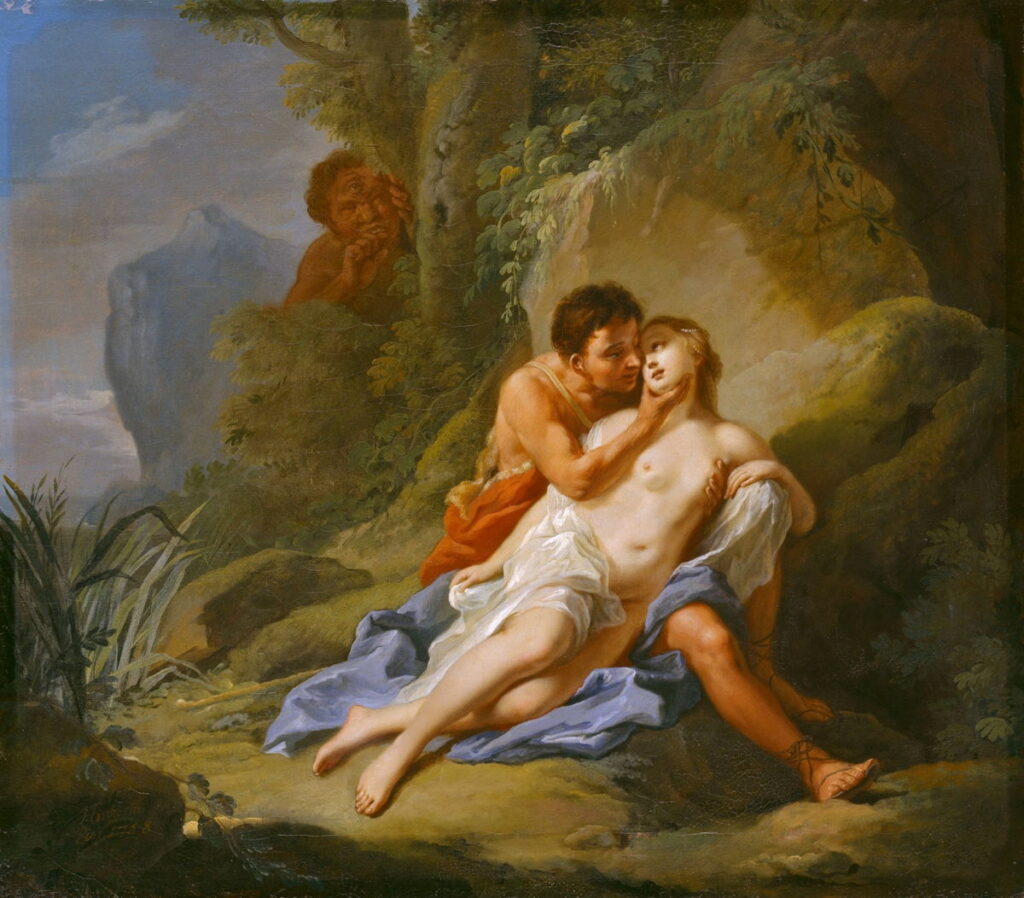Changing Paintings: 63 The tragedy of Galatea

As Ovid nears the end of Book 13 of his Metamorphoses, Aeneas and his companions are in transit across the Mediterranean, heading towards Italy and destiny. He rushes them through a rapid succession of adventures before bringing them to Sicily for the closing stories in this book.
Ovid summarises much of Virgil’s Aeneid in just a few lines, taking Aeneas from Crete through Ithaca, Samos, Dodona, and Phaeacia, to land on Sicily, where Scylla and Charybdis threaten the safety of mariners. Scylla is combing the hair of Galatea, as the latter laments her tragic love-life. Wiping tears from her eyes, Galatea then tells us her story.
When he was only sixteen, Galatea had fallen in love with Acis, the son of the river nymph Symaethis, but the Cyclops Polyphemus fell in love with her. The Cyclops did his best to smarten himself up for her, while remaining deeply and murderously jealous of Acis.
Telemus, a seer, visited Sicily and warned Polyphemus that Ulysses would blind his single eye, as told in a separate story in Homer’s Odyssey. This inevitably upset the Cyclops, who climbed a coastal hill and sat there playing his reed pipes. Meanwhile, Galatea was lying in the arms of her lover Acis, hidden behind a rock on the beach.
Polyphemus then launched into a long soliloquy imploring Galatea to come to him and spurn Acis. When he saw the two lovers together, he grew angry, and shouted loudly at them that that would be their last embrace. Galatea dived into the sea, but her lover was buried by the side of a mountain hurled by the Cyclops. The blood of Acis was turned into a stream that gushed forth from a reed growing in a cleft in the rock, with him as its river-god.
Claude Lorrain (1604/1605–1682), Coastal Landscape with Acis and Galatea (1657), oil on canvas, 102.3 × 136 cm, Gemäldegalerie Alte Meister, Staatliche Kunstsammlungen Dresden, Dresden, Germany. Wikimedia Commons.
Claude’s wonderful Coastal Landscape with Acis and Galatea (1657) is first and foremost a coastal landscape, but also tells Ovid’s story faithfully. Polyphemus is seen at the right, watching Acis and Galatea in their makeshift shelter down at the water’s edge, with Cupid sat beside them. Additional Nereids are tucked away in the trees at the left.
Nicolas Bertin (1667–1736) Acis and Galatea (c 1700), oil on canvas, 71 × 55 cm, Musée des beaux-arts de Carcassonne, Carcassonne, France. Wikimedia Commons.
Nicolas Bertin’s Acis and Galatea from around 1700 also follows Ovid’s detail. At its centre, the two lovers are behind a rock pinnacle, with three cupids sealing their love. Polyphemus is already in a rage at the upper right, although he hasn’t yet armed himself with the huge boulder. Below the couple Bertin provides a link into Ovid’s greater narrative, with Scylla and Charybdis, and possibly the goddess Venus with her son Cupid by her breast.
Johann Heinrich Tischbein (1722–1789), Acis and Galatea (1758), oil on canvas, 40.8 × 47 cm, Neue Galerie und Städtische Kunstsammlungen, Kassel, Germany. Wikimedia Commons.
Johann Heinrich Tischbein prefers a plainer account in his Acis and Galatea from 1758. Galatea is almost naked in the arms of Acis, as Polyphemus peers at them, a voyeur behind a tree trunk. There are now no cupids or other distractions.
Alexandre Charles Guillemot (1786-1831), The Love of Acis and Galatea (1827), oil on canvas, 146 × 111 cm, Private collection. Wikimedia Commons.
Alexandre Charles Guillemot’s The Love of Acis and Galatea (1827) doesn’t pursue the theme of Polyphemus’ voyeurism, but returns to a more conventional composition of the Cyclops sitting on a distant hill. He also sows potential confusion: Polyphemus is holding his reed pipes, although they are harder to see, and the pipes on Acis’ back are extras that are perhaps a little too obvious.
Later in the nineteenth century, emphasis switched from the jealousy of Polyphemus at the sight of the couple together, to Tischbein’s theme of voyeurism.
Gustave Moreau (1826–1898), Galatea (c 1880), oil on panel, 85.5 × 66 cm, Musée d’Orsay, Paris. Wikimedia Commons.
Gustave Moreau’s first Galatea from about 1880 shows her resting naked, alone in the countryside with her eyes closed, as the Cyclops plays sinister voyeur. Surrounding them is a magical countryside, filled with strange plants recalling anemones, as would be more appropriate for a sea-nymph. Acis is nowhere to be seen.
Gustave Moreau (1826–1898), Galatea (1896), gouache on wove paper, 39.5 x 25.7 cm, Harvard Art Museums/Fogg Museum (Bequest of Grenville L. Winthrop), Cambridge, MA. Courtesy of Harvard Art Museums.
Moreau’s second Galatea from near the end of his career in 1896 is dark, and shows Galatea and Polyphemus hemmed in within a deep canyon. Around her aren’t flowers but the seaweeds and corals more appropriate for a sea-nymph.
Odilon Redon (1840–1916), The Cyclops (c 1914), oil on cardboard mounted on panel, 65.8 × 52.7 cm, Kröller-Müller Museum, Otterlo, The Netherlands. Wikimedia Commons.
One of the masterpieces of Symbolism, Odilon Redon’s The Cyclops from about 1914 follows Redon’s personal theme of the eye and sight, and further develops that of voyeurism. Polyphemus’ face is now dominated by his single eye looking down over Galatea’s naked beauty, with Acis absent.
Curiously, none of the above paintings shows the moment of climax, or peripeteia, in which Polyphemus murders Acis.
Pompeo Batoni (1708–1787), Acis and Galatea (1761), oil on canvas, 98.5 x 75 cm, Nationalmuseum, Stockholm, Sweden. Wikimedia Commons.
Only Pompeo Batoni’s Acis and Galatea from 1761 shows the Cyclops, his reed pipes at his feet, hurling the boulder at Acis, so making clear the couple’s tragic fate.


